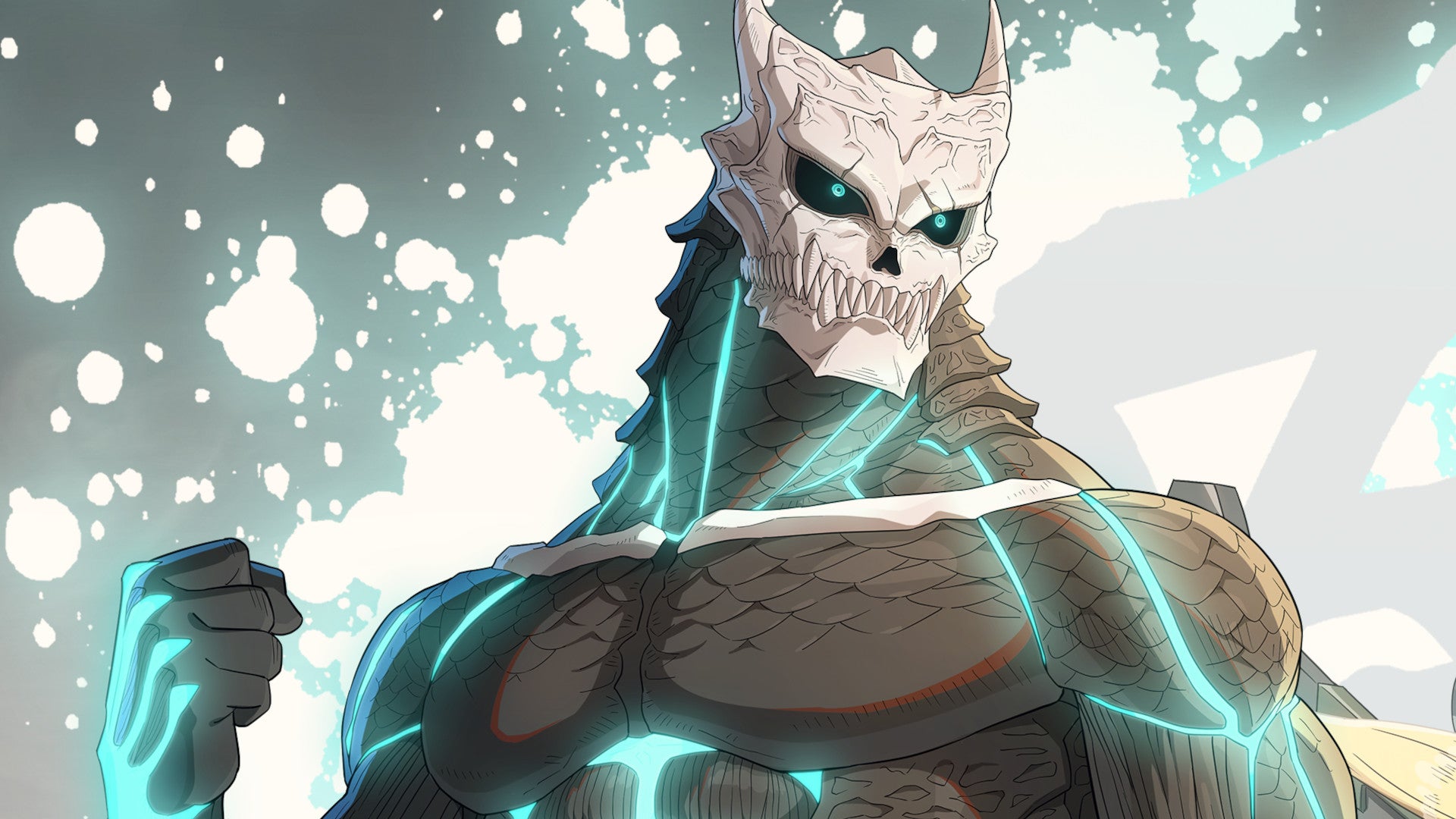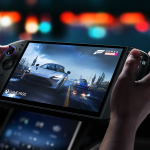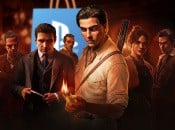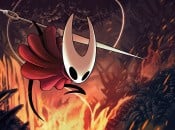
The Making of Kaiju No. 8: The Game
Most of the time, a game based on a successful manga is made after the anime adaptation has been airing for some time, but that wasn’t the case with Kaiju No. 8 The Game. (You can read our hands-on impressions here, by the way.) It tells its own story within creator Naoya Matsumoto’s world, as well as referencing pivotal events from the mainline narrative, and is one of the rare instances in which the game and anime were being developed in parallel.
“When this game began its development, the manga was only getting started,” says Kaiju No. 8 The Game’s Producer Shinya Fujita. “So there was still a lot of information that we didn’t know yet. And also at the same time, the manga was to be adapted into an anime as well. So this made it very difficult.”
The team started working on Kaiju No. 8 The Game more than two years ago, and the anime only started airing in mid-April last year. This meant that the game development team and the anime production effort (which involved both Production I.G and Studio Khara) were both exploring what this world would look like in action and how best to bring the characters – and kaiju – to life.
Akatsuki Games “often referred to the manga for unreleased characters, weapons, and locations,” reflects Fujita. The team also had access to Naoya Matsumoto, the writer and illustrator of the manga, and “his advice and support were crucial,” confirms Fujita, who goes on to say that he was “surprised by his deep knowledge of game development and respect for the process.”
That’s not to say that Akatsuki Games was disconnected from the anime. As its production moved ahead, the team were able to work with both studios on specific things. Fujita says that while his team looked to the manga for their character designs, they received invaluable help for the weapon designs from Production I.G, who “were able to create references that were very detailed and easy to understand”, and leveraged the expertise they’d gleaned from the likes of Ghost in the Shell. The team also received references for kaiju designs from Studio Khara, which had been brought onboard to oversee the kaiju designs in the anime; a natural fit given this is the studio established by Hideki Anno and responsible for the Rebuild of Evangelion films.
Kaiju No. 8 The Game GameplayThe work on background designs also lined up with the anime. “We received a lot of art boards from Production I.G,” says 3D Artist Kazushi Matsumoto. “Every day we’d be checking what the new materials were. In the early stages sometimes we’d find that our 3D design didn’t match the art board so we’d have to remake it. It’s not like we had all the reference material we needed in the first place – we had to work closely with Production I.G. In the case that we had exactly the same location as the anime, we’d have Production I.G review our designs as well.”
One area that was completely separate, however, was the audio side of the game. “I deeply admire the anime’s exceptional music,” says Sound Artist Yasuaki Iwata, “and the sound team is inspired by the anime’s music and takes a reference [from it] while creating entirely new compositions tailored specifically for the game experience.”
“Since music strongly reflects a composer’s individuality,” adds Sound Director Mitsuhiro Hikino, “we carefully structured our team. We were fortunate to have experienced game composers with extensive game experience and theatrical music composers who excel at creating music that complements visuals… We centered our music around genres like Japanese digital rock and used instrumentation familiar to fans of the IP and its culture. We deliberately kept melodies subtle to prevent the music from overpowering the experience, instead allowing it to complement and enhance the impressive visuals.”
Producing work that stands up next to the excellent anime was obviously important to the team, but so too was ensuring that the manga’s author, Naoya Matsumoto, was happy with their vision for his world. And sometimes that meant changing tack. Japanese mobile games often have provocative new outfits for their characters that players can acquire through their gacha system, incentivising them to invest more time and/or money in the game.
“Sexy costumes… [are] pretty common in the Japanese mobile game industry,” says Art Director Yuya Kuroyabu. “When we proposed this plan, Matsumoto-sensei said ‘well, no – this [approach] is not for this IP.’ So we studied the IP concept again and tried to come up with some unique designs for this game.” The upshot is that the character outfits stay true to the fact that they’re all soldiers in the Japan Anti-Kaiju Defense Force or CLOZER (a specialised military outfit central to the story), keeping this game more closely aligned with the manga and anime, and reworking the concept of ‘fan service’ in the process. “The essence of the design,” concludes Kuroyabu, “is the military style.”
Most important of all, however, was getting Matsumoto’s blessing for Kaiju No. 8 The Game’s original storyline. It takes place at a specific time in the manga and anime’s arc, and features all the main characters. “We, the game developers, proposed ideas [to Matsumoto-sensei],” Producer Shinya Fujita explains. “We wanted to create a unique setting for the game,” so came up with the concept that Kaiju Dimensional Gates were opening up around the globe, triggering an all-in response from anti-kaiju forces. “Then, building on to the Kaiju Dimensional Gate setting,” Fujita continues, “we created the original story and then created the character Sagan Shinomiya.”
The three original characters, with Sagan front and centre.“Sagan is a very important character,” Fujita explains, “because she’s the only game-original character connected to the anime/manga cast.” Given how central Kikoru and Isao Shinomiya are to Kaiju No. 8’s story, it genuinely is a pretty big deal for the game to introduce Kikoru’s non-blood related sister. “We didn’t actually have any instructions from Matsumoto-sensei,” says Art Director Yuya Kuroyabu on whether the team had free reign to create the character, “but we proposed ideas and spent a lot of time communicating.”
This included pivoting away from what Fujita describes as “a completely different character design” to find the current version which “was the better fit for this military setting.” “Because she plays such an important role, we wanted to make sure we get her right,” he concludes.
“Sagan is a very important character, because she’s the only game-original character connected to the anime/manga cast.” – Shinya Fujita
Sagan is joined by a couple of other new characters – Chester Lochburn, CLOZER’s strategist, and Suited, CLOZER’s weapons development guru – and the team have been quite clever in how they approach their gameplay designs. Characters in this game fall into three broad categories – Attacker, Support and Defender – and as you might imagine, given their overwhelming offensive power, many of the core cast from the manga/anime fit into the Attacker category. It makes sense, then, for the new characters to help bulk out the numbers in the other roles so that players can build well-rounded squads focused on their favourite characters.
With Matsumoto on board for the story and new characters, there was still the question of how to handle series protagonist Kafka Hibino. After all, he’s simultaneously one of the weakest and strongest characters in the manga/anime. The team have followed Matsumoto’s lead by keeping this duality and allowing Hibino to use his Ultimate to transform into Kaiju No. 8 mid-fight, going from a pistol packing support player to an absolute beast. It really is binary too, as his transformation completely replaces his human moves with kaiju ones and strips him of his pistol in favour of bare knuckle brawling. “After transforming, he gains access to powerful abilities like AOE attacks and high-damage Ultimate, allowing players to truly feel his strength,” says Producer Shinya Fujita.
The team have even created a standalone Kaiju No. 8 character that starts in Kafka’s transformed state. “While this version can’t equip weapons like other characters,” Fujita comments, “he possesses incredibly powerful base stats even without them. Pretty much what this means is that in the game you can skip the process of acquiring or leveling up weapons; he’s simply strong from the get go.” Even so, balance is key. “We want to avoid situations where a specific character becomes almost mandatory to progress,” explains Fujita, “or where players can’t freely use the characters they genuinely want to play.”
Kaiju No. 8 on the squad loadout screen.This is also reflected in the game’s monetisation strategy – which is always a thorny topic when it comes to live service titles, but particularly those with heavy gacha components. “Our goal is for fans to enjoy playing with their favourite characters, even if it impacts rarity,” says Fujita, “[so] we provide more opportunities for casual users to collect characters and enjoy the game.” The examples he gives of this are gifting players the choice of a rare character, as well as Kikoru/Kafka at launch, plus the free characters from the pre-registration campaign.
Coming back to Kafka, as you’d imagine he’s central to the game’s new story, and there’s a lot of it, with each mission bookended by cutscenes or dialogue sequences. If it feels to-the-point, that’s very much deliberate. “In the main Kaiju No. 8 story, the focus is heavily on maintaining narrative momentum,” explains Fujita, “and thus everyday life aspects are intentionally not depicted. To fill in those gaps, we created the character stories.” This is a separate mode with small stories based around the major characters. “We hope players will enjoy the casual conversations between characters and discover new parts of their personalities that aren’t seen in the main story.”
Even so, in keeping with the manga and anime, there are still some pretty goofy, playful sequences in the main story. “We’re trying to stay as true to the original work’s artistic direction as possible,” says Fujita, while also wanting to “show a ‘cooler side of Kafka’ in the game,” as compared with how he’s often portrayed in the anime.
“We’re trying to stay as true to the original work’s artistic direction as possible…” – Shinya Fujita
As for the enemies, this is where the game really takes off. “There will be 20-30 different genres [of kaiju],” says Art Director Yuya Kuroyabu. A few examples pulled from the series include Wyvern-type, Lizard-type and Ant-type, but we can’t wait to see what else the team comes up with. Kuroyabu mentioned that the team were inspired by kaiju movies, particularly the Tokusatsu genre, and utilised classic elements from those films such as low camera angles to emphasise size.
The kaiju designs also have to fit neatly into a fun gameplay framework. “Our core philosophy for this game is to prioritise clarity,” explains Producer Shinya Fujita, “so we’ve tried to give kaiju abilities that can be inferred from their appearance. For example, Fungal-Type kaiju might inflict status ailments like poison, while Spider-Types might use web attacks to reduce your speed.” These status effects may be easy enough to counter on their own, but when the game starts throwing multiple types at you simultaneously, it’s going to get a bit more complicated. You can read more about how the game plays in our hands-on impressions.
As for the kaiju design that Art Director Yuya Kuroyabu is most excited about, it comes down to how the team are helping to flesh out existing details in Matsumoto’s world. “The one I want to call out is Kaiju No. 1,” he says. “I forget which episode [it was in], but it did show up in the original manga and anime – but only from the bust up – so no one knew what the rest of it looked like… and now we’ve designed it, so you can find out in the game! We also used this kaiju as one of our key visuals as well. It’s a special one for me.”
More than a little imposing…3D Artist Kazushi Matsumoto shares a similar sentiment. “There are a lot of things that aren’t from the manga or anime that we’ve realised in the game,” he says, “so we’re looking forward to the players discovering them. Plus, we’ve prepared a lot of content for not only Kaiju No. 8 fans, but for Japanese anime lovers too.”
Now that Kaiju No. 8 The Game is out in the wild, there’s the question of what comes next. “We’re planning event stories that’ll let players get to know individual characters better,” says Fujita, “along with high-difficulty battle content for players seeking more challenging gameplay. And of course, we’re also planning story events featuring characters in special seasonal outfits.”
And presumably, in keeping with Matsumoto’s wishes, those outfits will not be overtly sexy. Regardless, “the most important thing” about running a live service game, says Fujita, “is to have love for the IP. Being a fan helps understand what other fans want.”
Cam Shea visited Akatsuki Games in Tokyo as a guest. He’s a former IGN staffer, now freelance writer and beer geek.











